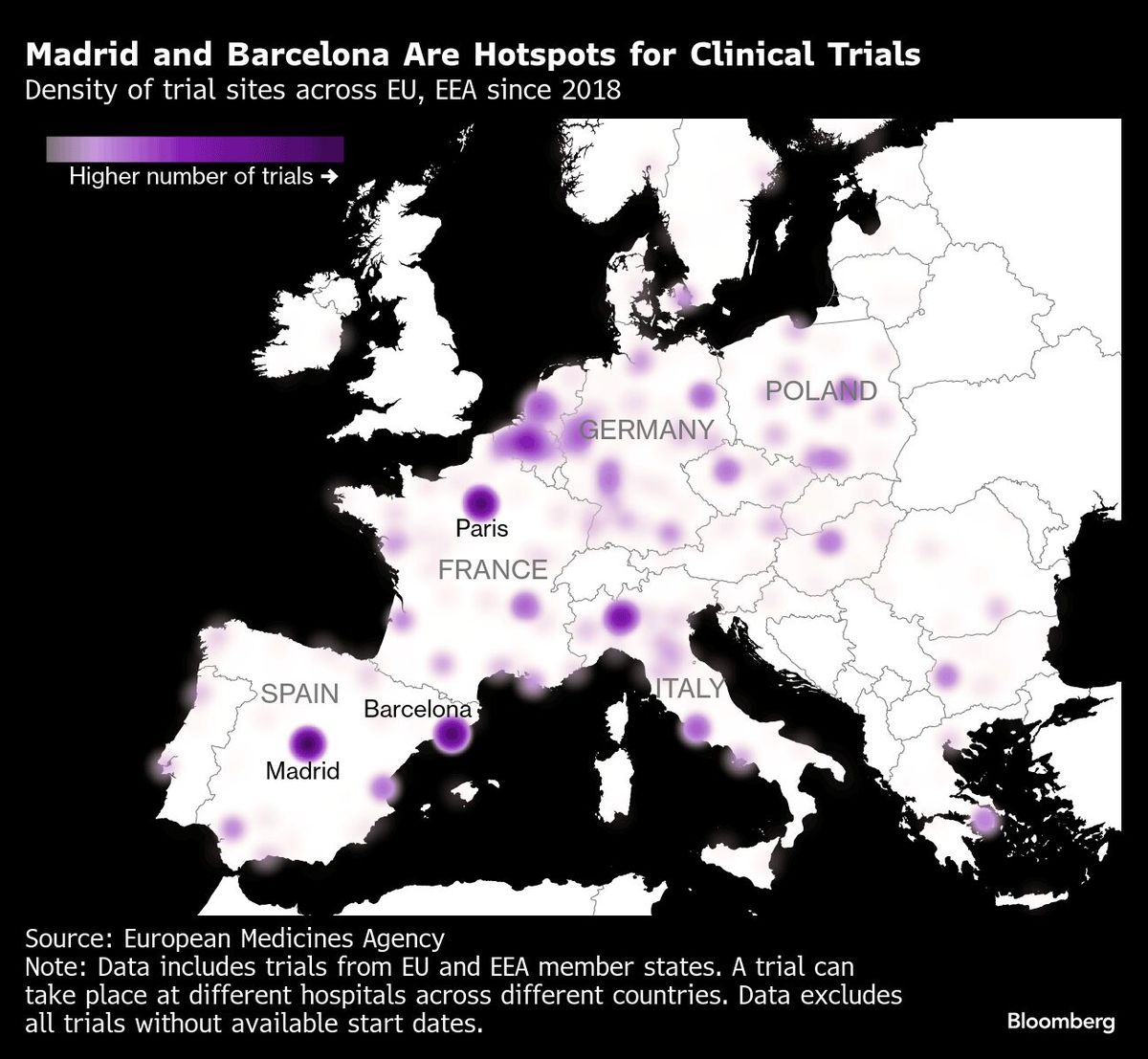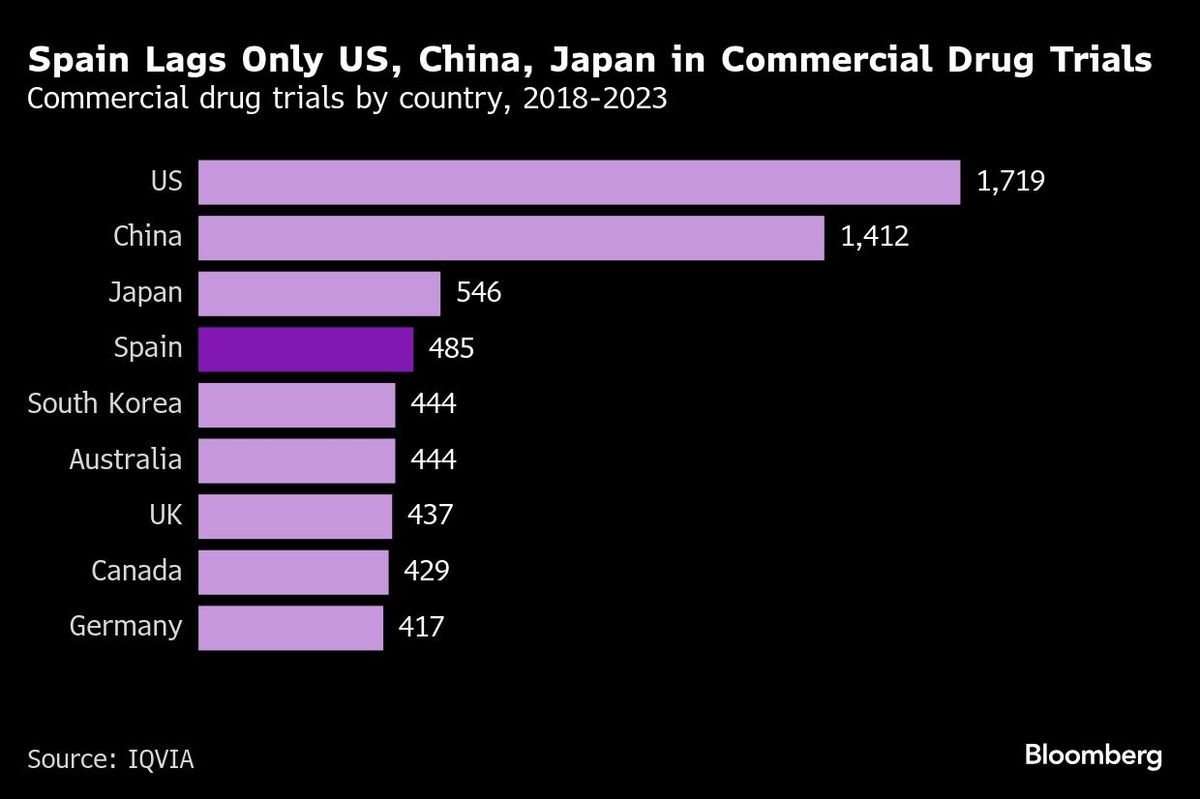
The Johnson & Johnson headquarters in Madrid.
(April 2): Big Pharma has aimed some choice words at European countries recently, including calling the UK “uninvestable” and warning that the region as a whole is fast losing its edge to China.
Yet even as Europe is buffeted by change — the clamour for Chinese biotech or, more recently, the rush to appease US President Donald Trump — one country is showing there could still be a way to build up a pharmaceutical industry: by giving companies what they want.
Spain has risen to the top of European rankings for clinical trials, using some of the region’s most generous tax breaks and a relatively speedy regulatory process to reduce the lag from the start of a drug trial to approval. Investors also point to comparable science quality at a cheaper price than rivals.
It’s a package that’s helped persuade AstraZeneca plc, Novartis AG, Roche Holding AG and others to expand their Spanish footprint in the last few years. Prime Minister Pedro Sánchez is keen to attract more and earlier this year gathered the likes of Johnson & Johnson, Daiichi Sankyo Co Ltd, Eli Lilly & Co and Sanofi to Madrid’s Palacio de La Moncloa for talks.
AstraZeneca chose Barcelona — where the UK-based company had just expanded its Alexion rare diseases division — to set up a new research hub in 2023, in part due to its health care ecosystem and quality of life for employees.
Initially, it pledged €800 million (RM3.84 billion) and 1,000 new roles between 2023 and 2027 in the city. That hiring target was hit last year, so AstraZeneca doubled the goal and upped funding to €1.3 billion. The company’s Spain president Rick R Suarez said in February it was on track to reach 2,000 hires two years early, raising the possibility of further expansion.
“Spain has become a key market for AstraZeneca globally and within Europe,” Suarez said in an interview, during which “strong public-private collaboration” came up often. It’s not just words, he insisted, it’s a “game-changer”.
The government has facilitated work with hospitals in Spain’s state-run system, he said, as well as startups and promising scientists. The mayor of Barcelona has stepped up, with city officials helping new employees, who joined on local contracts, access health care, housing and even secure a driving licence.
Biotech executives, scientists and investors told Bloomberg similar stories about officials going the extra mile. Spanish media has reported Sanofi is planning to choose Barcelona for a new research centre, though the French drugmaker declined to comment.
Competition
Yet even as Spain has shown it can win at the zero-sum game when companies weigh up where to invest, the government is facing calls to do more to lock in its advantage. Pharmaceutical firms can turn on a dime if incentives change.
It’s what the UK discovered when AstraZeneca scrapped plans for a vaccine plant this year over the level of public funding. Many of the company’s projects are “associated with partnerships with local governments”, CEO Pascal Soriot said. It “just happened that we didn’t get the support”.
Amid the public finger-pointing, the newly elected Labour government said there was a “remarkably small” difference between its offer and what AstraZeneca agreed with the previous Conservative administration — and it was because the company scaled back its research and development plans at the site.
For critics, it fit a picture of decline — as well as an illustration of how fast trends can change. From a prominent position about a decade ago, the UK now trails in key metrics including drug access and clinical trials, seen as a bellwether for a healthy life sciences industry. It was recently labelled “uninvestable” by an industry lobby group due to soaring costs.
Top-ranked
Spain has moved in the opposite direction and now ranks first in Europe in clinical trials, according to researcher IQVIA. Much of the activity is around Madrid and Barcelona, with their hospitals, research institutions and biotechs.
Funding is a major factor. The government offers tax credits of about 33% for large companies’ spending on research and development, well above the European average of 15%, according to the Tax Foundation Europe think tank.
There are also tax breaks for employees moving to Spain, including the so-called Beckham law, named after ex-Real Madrid star David Beckham, that allows foreigners to pay a lower income tax rate for a fixed period.
For smaller companies like fertility-focused Oxolife, government support accounts for about 50% of their funds, CEO Agnès Arbat told Bloomberg. Spain is also one of the most cost-effective countries in Europe for clinical research and significantly cheaper than Germany or France, she said.
It was the first EU member to adopt the bloc’s directive on clinical trial research, making it more competitive, said Oscar Salamanca, head of the Spanish Association of Contract Research Organisations. For example, it takes three to four months from submitting approval documentation to potentially treating the first patient, he said, compared to at least six elsewhere.
Several executives talked of Barcelona’s appeal. Belgian scientist Valerie Vanhooren came for personal reasons and reeled off a familiar list of attributes: good hospitals, government support and top-notch research.
The CEO of biotech Ona Therapeutics said her company’s breakthrough came via an email from the nearby Hospital Clinic de Barcelona, telling her they had samples for a likely drug target but needed help to develop a treatment.
Sara Secall, general partner at alternative asset manager Inveready, said the life sciences sector has transformed over the past decade. Whereas previously only local investors took an interest, Spain is “on the map finally”, she said.
Challenges
Spain’s Health Secretary Javier Padilla said the key to growing the life sciences industry lies with the country’s public health system. Though it is managed by 17 regional governments, it is among the most integrated in Europe and ranks inside the top 10 countries globally for drug purchases, he said.
“It’s not a country that offers high margins but it has a lot of volume,” he said. That puts it on drugmakers’ radars while giving the government leverage.
Still, while Spain has increased funding for research and development by more than 50% between 2017 and 2023, it’s still well below what Germany, the UK and Denmark spend relative to GDP. Danish firm Novo Nordisk A/S’s windfall from its Ozempic weight-loss drug is fuelling economic growth and a booming biotech sector.
Spain also lags rivals including Germany, Switzerland and France in adopting approved drugs, according to Salamanca, who said the government often drags its feet to avoid having to spend more.
“If you’re a patient going for a clinical trial, they’ll give you the latest medication,” he said. “But if you go for a regular consultation, there may not be a reimbursement price for that drug and so you can’t be treated with it.”
The government wants to address some of these issues, said Padilla. It is working with companies like Johnson & Johnson on funding systems that could be tied to results and looking at ways to lift investment in basic research. It also plans to accelerate adoption of new drugs.
The question is whether Spain’s rise is sustainable as competing threats loom, such as the lure of untapped scientific potential in China or the industry’s need to get on the right side of Trump’s tariffs. AstraZeneca, for example, recently announced a new US$2.5 billion (RM11.12 billion) research centre in Beijing.
Sanchez’s meeting with pharma executives in February followed a similar one in 2022 — sitting back isn’t an option if the premier wants them to keep coming.
Uploaded by Arion Yeow
- FBM KLCI down 4.17% to more than two-year low on global trade war woes
- Asian stock benchmarks drop most in 14 years on tariff concerns
- China has already trade-war-proofed its economy
- Trump team rejects market fears, shows defiance on tariffs
- Malaysia should not panic, rush into decisions over US tariffs, says Amir Hamzah
- Asian stock benchmarks drop most in 14 years on tariff concerns
- Yen, Swiss franc jump in volatile trade as global recession fears grow
- Anwar: Tackle issues effectively to avoid exploitation by irresponsible parties
- Alternative Views: After tariff tantrum, watch out for currency wars
- Short selling in five counters suspended amid market rout



